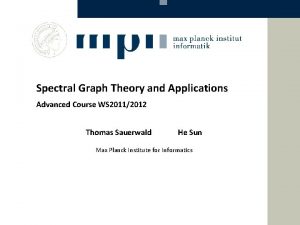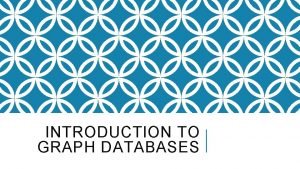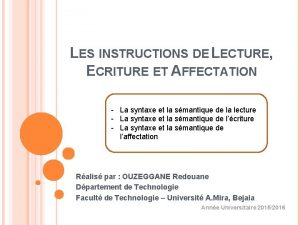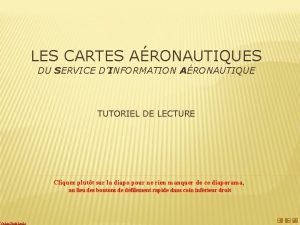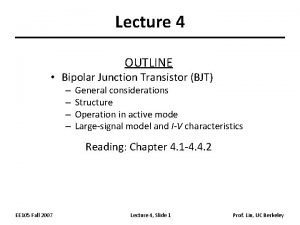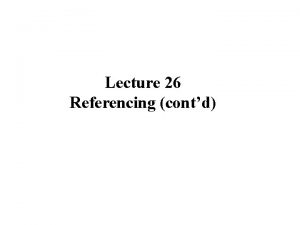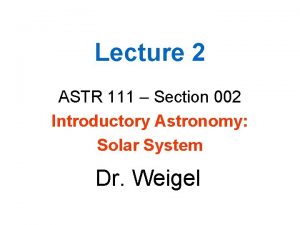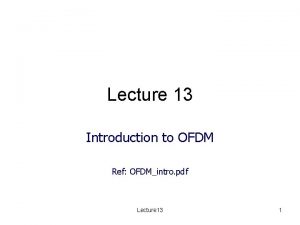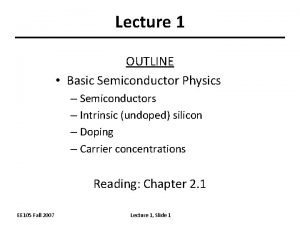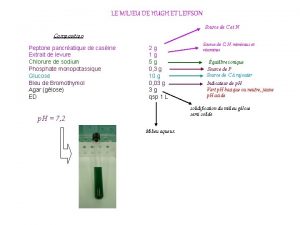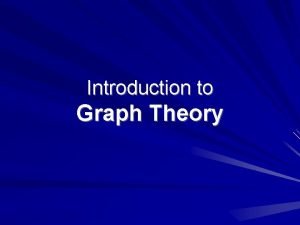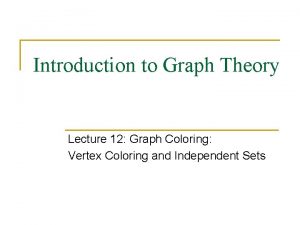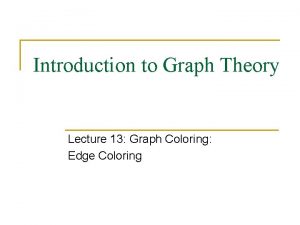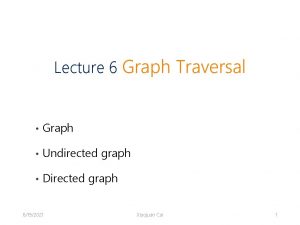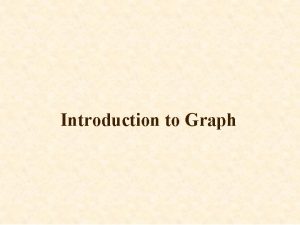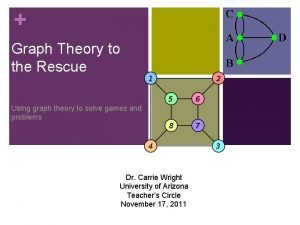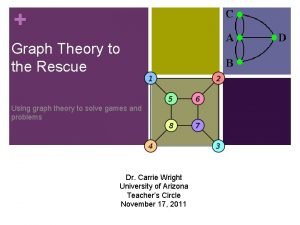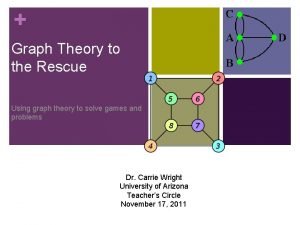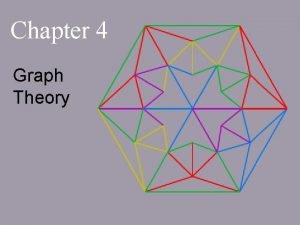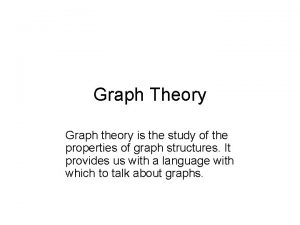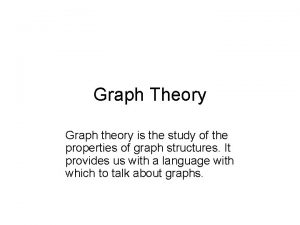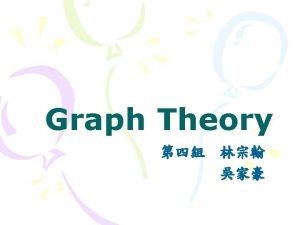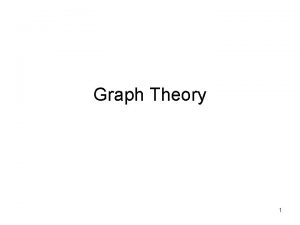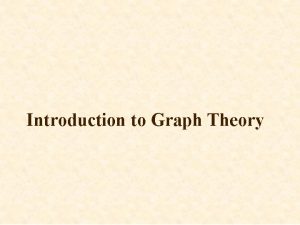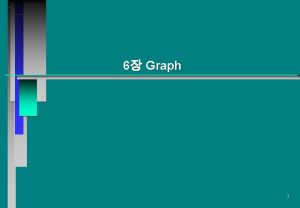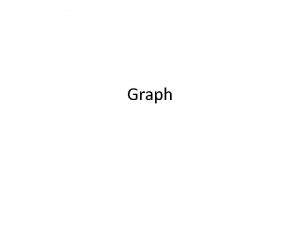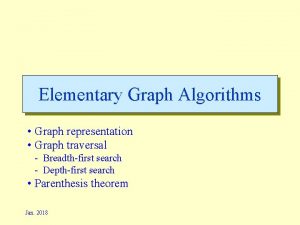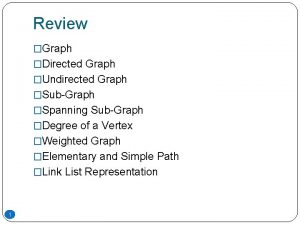GRAPH THEORY Lecture 22 1 INTRODUCTION Graph theory









































![SYMMETRIC MATRIX square matrix A = [aij] of size n n is called symmetric SYMMETRIC MATRIX square matrix A = [aij] of size n n is called symmetric](https://slidetodoc.com/presentation_image_h2/6b454a98e351aa7ee6cf7600bea6ebed/image-42.jpg)


















- Slides: 60

GRAPH THEORY Lecture # 22 1

INTRODUCTION � Graph theory plays an important role in several areas of computer science such as: � Switching Theory and Logical Design � Artificial Intelligence � Formal Languages � Computer Graphics � Operating Systems � Compiler Writing � Information Organization and Retrieval. 2

GRAPH �A graph is a non-empty set of points called vertices and �A set of line segments joining pairs of vertices called edges. � Formally, a graph G consists of two finite sets: A set V = V(G) of vertices (or points or nodes) � A set E = E(G) of edges; � 3 where each edge corresponds to a pair of vertices.

EXAMPLE � We have five vertices labeled by v 1, v 2, v 3, v 4, v 5. � We have edges e 1, e 2, e 3, e 4, e 5, e 6. 4

� e 1 edge is for vertices v 1 and v 2. � e 2 and e 3 are end points v 1 and v 4. � e 4 has end points v 2 and v 4. � e 5 has end points v 2 and v 3. � e 6 is a loop. 5

SOME TERMINOLOGY � An edge connects either one or two vertices called its endpoints (edge e 1 connects vertices v 1 and v 2 described as {v 1, v 2} i. e v 1 and v 2 are the endpoints of an edge e 1). 6

� An edge with just one endpoint is called a loop. Thus a loop is an edge that connects a vertex to itself (e. g. , edge e 6 ). � Two vertices that are connected by an edge are called adjacent; and a vertex that is an endpoint of a loop is said to be adjacent to itself. � An edge is said to be incident on each of it endpoints(i. e. e 1 is incident on v 1 and v 2 ). 7

�A vertex on which no edges are incident is called isolated (e. g. , v 5) � Two distinct edges with the same set of end points are said to be parallel (i. e. e 2 & e 3). 8

EXAMPLE � Define the following graph formally by specifying its vertex set, its edge set, and a table giving the edge endpoint function. 9

SOLUTION Vertex Set = {v 1, v 2, v 3, v 4} Edge Set = {e 1, e 2, e 3} Edge - endpoint function is: Edge Endpoint e 1 {v 1, v 2} e 2 {v 1, v 3} e 3 {v 3} 10

EXAMPLE � For the graph shown below: � Find all edges that are incident on v 1; � Find all vertices that are adjacent to v 3; � Find all loops; � Find all parallel edges; � Find all isolated vertices; 11

SOLUTION � Find all edges that are incident on v 1? �v 1 is incident with edges e 1, e 2 and e 7 all vertices that are adjacent to v 3? �vertices adjacent to v 3 are v 1 and v 2 � Find all loops? �Loops are e 1 and e 3 � Find 12

� Find all parallel edges? �Only edges e 4 and e 5 are parallel � Find all isolated vertices? �The only isolated vertex is v 4 in this Graph. 13

EXERCISE � Draw picture of Graph H having vertex set {v 1, v 2, v 3, v 4, v 5} and edge set {e 1, e 2, e 3, e 4} with edge endpoint function: Edge Endpoint e 1 {v 1} e 2 {v 2, v 3} e 3 {v 2, v 3} e 4 {v 1, v 5} 14

EXERCISE � Given V(H) = {v 1, v 2, v 3, v 4, v 5} and E(H) = {e 1, e 2, e 3, e 4} with edge endpoint function Edge Endpoint e 1 {v 1} e 2 {v 2, v 3} e 3 {v 2, v 3} e 4 {v 1, v 5} 15

SIMPLE GRAPH �A simple graph is a graph that does not have any loop or parallel edges. � Example: � It is a simple graph H V(H) = {v 1, v 2, v 3, v 4, v 5} & E(H) = {e 1, e 2, e 3, e 4} 16

EXERCISE � Draw all simple graphs with the four vertices {u, v, w, x} and two edges, one of which is {u, v}. � Solution: We are given four vertices {u, v, w, x} and one edge is {u, v}. Since we are interested in simple graph so we cannot take {u, v} again. 17

� There are C(4, 2) = 6 ways of choosing two vertices from 4 vertices. � These edges may be listed as: {u, v}, {u, w}, {u, x}, {v, w}, {v, x}, {w, x} � One edge of the graph is specified to be {u, v}, so any of the remaining five from this list may be chosen to be the second edge. � This 18 required graphs are:

19

DEGREE OF A VERTEX � Let G be a graph and v a vertex of G. The degree of v, denoted deg(v), equals the number of edges that are incident on v, with an edge that is a loop counted twice. � The total degree of G is the sum of the degrees of all the vertices of G. � The 20 degree of a loop is counted twice.

EXAMPLE � For � deg the graph shown (v 1) = 0, since v 1 is isolated vertex. � deg (v 2) = 2, since v 2 is incident on e 1 and e 2. � deg (v 3) = 4, since v 3 is incident on e 1, e 2 and the loop e 3. � Total degree of G = deg(v 1) + deg(v 2) + deg(v 3) =0+2+4=6 21

NOTE � The total degree of G, which is 6, equals twice the number of edges of G, which is 3. � This is always the case the total degree of graph is always twice the number of edges in that graph. This is actually theorem called Handshaking Theorem. 22

THE HANDSHAKING THEOREM � If G is any graph, then the sum of the degrees of all the vertices of G equals twice the number of edges of G. � Specifically, if the vertices of G are v 1, v 2, …, vn, where n is a positive integer, then � The total degree of G = deg(v 1) + deg(v 2) + … + deg(vn) = 2. (the number of edges of G) 23

COROLLARY � The 24 total degree of G is an even number

EXERCISE � Draw a graph with the specified properties or explain why no such graph exists. (i) Graph with four vertices of degrees 1, 2, 3 and 3 (ii) Graph with four vertices of degrees 1, 2, 3 and 4 (iii) Simple graph with four vertices of degrees 1, 2, 3 and 4. 25

(i) Graph with four vertices of degrees 1, 2, 3 and 3 Total degree of graph = 1 + 2 + 3 = 9 an odd integer Hence by Hand-Shaking Theorem, first graph is not possible. 26

(ii) Graph with four vertices of degrees 1, 2, 3 and 4 Total degree of graph = 1 + 2 + 3 = 10 an even integer � The vertices a, b, c, d have degrees 1, 2, 3, and 4 respectively (i. e. graph exists). deg(a) = 1 deg(c) = 3 27 deg(b) = 2 deg(d) = 4

deg(a) = 1 deg(b) = 2 deg(c) = 3 deg(d) = 4 28 deg(a) = 1 deg(b) = 2 deg(c) = 3 deg(d) = 4

(iii) Simple graph with four vertices of degrees 1, 2, 3 and 4. � Suppose there was a simple graph with four vertices of degrees 1, 2, 3, and 4. Then the vertex of degree 4 would have to be connected by edges to four distinct vertices other than itself because of the assumption that the graph is simple (and hence has no loop or parallel edges. ) This contradicts the assumption that the graph has four vertices in total. � Hence there is no simple graph with four vertices of degrees 1, 2, 3, and 4, so simple graph is not possible in this case. 29

EXERCISE � Suppose a graph has vertices of degrees 1, 1, 4, 4 and 6. How many edges does the graph have? � SOLUTION: The total degree of graph = 1 + 4 + 6 = 16 Number of edges of graph = 30

COMPLETE GRAPH �A complete graph on “n” vertices is a simple graph in which each vertex is connected to every other vertex and is denoted by Kn (Kn means that there are n vertices). 31

REGULAR GRAPH �A graph G is regular graph of degree k or k-regular if every vertex of G has degree k. � In other words, a graph is regular if every vertex has the same degree. � Following 32 are some regular graphs.

33

EXERCISE � Draw two 3 -regular graphs with six vertices. � SOLUTION: 34

BIPARTITE GRAPH �A bipartite graph G is a simple graph whose vertex set can be partitioned into two mutually disjoint non empty subsets A and B such that the vertices in A may be connected to vertices in B, but no vertices in A are connected to vertices in A and no vertices in B are connected to vertices in B. 35

MATRIX REPRESENTATIONS OF GRAPHS � To store graph in computer with pictorial representation is not possible rather you will store the graph with matrix representation. � It is difficult to analyze a big complex graph with hundreds of vertices and thousands of edges, but in matrix form you can analyze big graph better. 36

MATRIX m n matrix A over a set S is a rectangular array of elements of S arranged into m rows and n columns: � An jth column of A Briefly, it is written as: A = [aij ] m n 37

EXAMPLE �A is a matrix having 3 rows and 4 columns. We call it a 3 4 matrix, or matrix of size 3 4(or we say that a matrix having an order 3 4). � Note: a 11 = 4 (11 means 1 st row and 1 st column), a 12 = -2 (12 means 1 st row and 2 nd column), a 13 = 0, a 14 = 6 a 21 = 2, a 22 = -3, a 23 = 1, a 24 =9 etc. 38

SQUARE MATRIX �A matrix for which the number of rows and columns are equal is called a square matrix. Diagonal entries � The 39 main diagonal of A consists of all the entries a 11, a 22, a 33, …, aii, …, ann

TRANSPOSE OF A MATRIX transpose of a matrix A of size m n, is the matrix denoted by At of size n m, obtained by writing the rows of A, in order, as columns. � The 40

EXAMPLE � Then 41
![SYMMETRIC MATRIX square matrix A aij of size n n is called symmetric SYMMETRIC MATRIX square matrix A = [aij] of size n n is called symmetric](https://slidetodoc.com/presentation_image_h2/6b454a98e351aa7ee6cf7600bea6ebed/image-42.jpg)
SYMMETRIC MATRIX square matrix A = [aij] of size n n is called symmetric if, and only if, At= A i. e. , for all i, j = 1, 2, …, n, aij = aji �A 42

EXAMPLE � Note 43 that Bt = B, so that B is a symmetric matrix.

MATRIX MULTIPLICATION � Note: If the number of columns of A is not equal to the number of rows of B, then the product AB is not defined. 44

EXAMPLE � Find the product AB and BA of the matrices � SOLUTION: Size of A is 2 2 and of B is 2 3, the product AB is defined as a 2 3 matrix. 45

46

ADJACENCY MATRIX OF A GRAPH � Let G be a graph with ordered vertices v 1, v 2, . . . , vn. The adjacency matrix of G is the matrix A = [aij] over the set of non-negative integers such that aij = the number of edges connecting vi and vj for all i, j = 1, 2, …, n. OR � The adjancy matrix say A= [aij] is also defined as 47

EXAMPLE A graph with it’s adjacency matrix is shown. � � Clearly graph has four vertices. It means that the corresponding square matrix will be order 4 x 4. 48

EXERCISE � Find a graph that have the following adjacency matrix. � Its order is 3 x 3, it means its corresponding graph has three vertices. � Let the three vertices of the graph be named v 1, v 2 and v 3 49

50

DIRECTED GRAPH �A directed graph or digraph, consists of two finite sets: a set V(G) of vertices and a set D(G) of directed edges, � where each edge is associated with an ordered pair of vertices called its end points. � If edge e is associated with the pair (v, w) of vertices, then e is said to be the directed edge from v to w and is represented by drawing an arrow from v to w. 51

EXAMPLE OF DIGRAPGH 52

ADJACENCY MATRIX OF A DIRECTED GRAPH � Let G be a graph with ordered vertices v 1, v 2, …, vn. � The adjacency matrix of G is the matrix A = [aij] over the set of non-negative integers such that aij = the number of arrows from vi to vj for all i, j = 1, 2, …, n. 53

EXAMPLE �A directed graph with its adjacency matrix is shown Adjacency matrix 54

EXERCISE � Find � The directed graph that has the adjacency matrix order of matrix is 4 x 4, it means it has 4 vertices. 55

SOLUTION 4 4 adjacency matrix shows that the graph has 4 vertices say v 1, v 2, v 3 and v 4 labeled across the top and down the left side of the matrix. � The 56

�A � It corresponding directed graph is means that a loop exists from v 1 and v 3 , two arrows go from v 1 to v 4 and two from v 3 and v 2 and one arrow go from v 1 to v 3 , v 2 to v 3 , v 3 to v 4, v 4 to v 2 and v 3. 57

INCIDENCE MATRIX OF A SIMPLE GRAPH � Let G be a graph with vertices v 1, v 2, …, vn and edges e 1, e 2, …, en. � The incidence matrix of G is the matrix M = [mij] of size n m defined by: 58

EXERCISE �A 59 graph with its incidence matrix is shown.

REMARK � In the incidence matrix: � Parallel edges are represented by columns with identical entries (in this matrix e 4 & e 5 are parallel edges). � Loops are represented using a column with exactly one entry equal to 1, corresponding to the vertex that is incident with this loop and other zeros (here e 2 is only a loop). 60
 01:640:244 lecture notes - lecture 15: plat, idah, farad
01:640:244 lecture notes - lecture 15: plat, idah, farad Graph neural network lecture
Graph neural network lecture Bridge graph
Bridge graph Introduction to biochemistry lecture notes
Introduction to biochemistry lecture notes Introduction to psychology lecture
Introduction to psychology lecture Introduction to algorithms lecture notes
Introduction to algorithms lecture notes A brief introduction to spectral graph theory
A brief introduction to spectral graph theory Natural language processing nlp - theory lecture
Natural language processing nlp - theory lecture Decision theory lecture notes
Decision theory lecture notes Bayesian decision theory lecture notes
Bayesian decision theory lecture notes Natural language processing lecture notes
Natural language processing lecture notes Game theory and graph theory
Game theory and graph theory Wait-for graph
Wait-for graph Graphdbs
Graphdbs Introduction to graph databases
Introduction to graph databases Body paragraph
Body paragraph Project procurement management lecture notes
Project procurement management lecture notes Lecture about sport
Lecture about sport Lecture on healthy lifestyle
Lecture on healthy lifestyle Makeup lecture meaning
Makeup lecture meaning Meaning of this
Meaning of this Randy pausch last lecture summary
Randy pausch last lecture summary Tensorflow lecture
Tensorflow lecture Theology proper lecture notes
Theology proper lecture notes Strategic management lecture
Strategic management lecture Geology lecture series
Geology lecture series Social psychology lecture
Social psychology lecture In text citation for a lecture
In text citation for a lecture Public sector notes
Public sector notes Project management notes
Project management notes Eurocode reinforcement detailing
Eurocode reinforcement detailing Magnetism
Magnetism Physics 111 lecture notes
Physics 111 lecture notes What is a harmonic wave in physics
What is a harmonic wave in physics Physical science lecture notes
Physical science lecture notes Power system dynamics and stability lecture notes
Power system dynamics and stability lecture notes Microbial physiology lecture notes
Microbial physiology lecture notes Application of mechatronics ppt
Application of mechatronics ppt Limits fits and tolerances lecture notes
Limits fits and tolerances lecture notes Didactique de la lecture au primaire
Didactique de la lecture au primaire Instruction de lecture
Instruction de lecture Aronautique
Aronautique Lecture title
Lecture title Slidetodoc
Slidetodoc Money-time relationship and equivalence
Money-time relationship and equivalence Quasi saturation in power bjt
Quasi saturation in power bjt Requirement analysis in software engineering notes
Requirement analysis in software engineering notes Katus lighting
Katus lighting Le registre dominant dans le dernier jour d'un condamné
Le registre dominant dans le dernier jour d'un condamné Tegrity lecture capture
Tegrity lecture capture Why is sincerity so important in social business letters?
Why is sincerity so important in social business letters? Bjt equations
Bjt equations Examples of harvard referencing
Examples of harvard referencing Lecture recipe
Lecture recipe The parsec lecture tutorial answers
The parsec lecture tutorial answers Ofdm lecture notes
Ofdm lecture notes Basic semiconductor physics:
Basic semiconductor physics: Milieu citrate de simmons
Milieu citrate de simmons Land use planning '' lecture notes
Land use planning '' lecture notes Grille de lecture systémique
Grille de lecture systémique La double énonciation dans antigone
La double énonciation dans antigone






